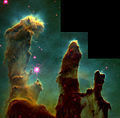File:Pillars of Creation.jpg

Original file (1,518 × 1,497 pixels, file size: 376 KB, MIME type: image/jpeg)
Captions
Captions
Summary[edit]
| DescriptionPillars of Creation.jpg |
English: For over twenty years the Hubble Space Telescope has taken many wonderful images from comet crashes to distant galaxies, including this iconic image of gas pillars in the Eagle Nebula (M16)
These eerie, dark pillar-like structures are columns of cool interstellar hydrogen gas and dust that are also incubators for new stars. The pillars protrude from the interior wall of a dark molecular cloud like stalagmites from the floor of a cavern. They are part of the "Eagle Nebula" (also called M16 - the 16th object in Charles Messier's 18th century catalog of "fuzzy" objects that aren't comets), a nearby star-forming region 6,500 light-years away in the constellation Serpens. The pillars are in some ways akin to buttes in the desert, where basalt and other dense rock have protected a region from erosion, while the surrounding landscape has been worn away over millennia. In this celestial case, it is especially dense clouds of molecular hydrogen gas (two atoms of hydrogen in each molecule) and dust that have survived longer than their surroundings in the face of a flood of ultraviolet light from hot, massive newborn stars (off the top edge of the picture). This process is called "photoevaporation. "This ultraviolet light is also responsible for illuminating the convoluted surfaces of the columns and the ghostly streamers of gas boiling away from their surfaces, producing the dramatic visual effects that highlight the three-dimensional nature of the clouds. The tallest pillar (left) is about about 4 light-years long from base to tip. As the pillars themselves are slowly eroded away by the ultraviolet light, small globules of even denser gas buried within the pillars are uncovered. These globules have been dubbed "EGGs." EGGs is an acronym for "Evaporating Gaseous Globules," but it is also a word that describes what these objects are. Forming inside at least some of the EGGs are embryonic stars - stars that abruptly stop growing when the EGGs are uncovered and they are separated from the larger reservoir of gas from which they were drawing mass. Eventually, the stars themselves emerge from the EGGs as the EGGs themselves succumb to photoevaporation. The picture was taken with the Hubble Space Telescope Wide Field and Planetary Camera 2. The color image is constructed from three separate images taken in the light of emission from different types of atoms. Red shows emission from singly-ionized sulfur atoms. Green shows emission from hydrogen. Blue shows light emitted by doubly- ionized oxygen atoms. |
| Date | |
| Source | http://solarsystem.nasa.gov/multimedia/display.cfm?Category=Planets&IM_ID=13343 |
| Author | NASA |
Licensing[edit]
| Public domainPublic domainfalsefalse |
| This file is in the public domain in the United States because it was solely created by NASA. NASA copyright policy states that "NASA material is not protected by copyright unless noted". (See Template:PD-USGov, NASA copyright policy page or JPL Image Use Policy.) |  | |
 |
Warnings:
|
File history
Click on a date/time to view the file as it appeared at that time.
| Date/Time | Thumbnail | Dimensions | User | Comment | |
|---|---|---|---|---|---|
| current | 17:58, 30 January 2013 |  | 1,518 × 1,497 (376 KB) | Stas1995 (talk | contribs) | User created page with UploadWizard |
You cannot overwrite this file.
File usage on Commons
There are no pages that use this file.
File usage on other wikis
The following other wikis use this file:
- Usage on ta.wikipedia.org
Metadata
This file contains additional information such as Exif metadata which may have been added by the digital camera, scanner, or software program used to create or digitize it. If the file has been modified from its original state, some details such as the timestamp may not fully reflect those of the original file. The timestamp is only as accurate as the clock in the camera, and it may be completely wrong.
| Online copyright statement | |
|---|---|
| Copyright status | Copyright status not set |
| Contact information |
, , |